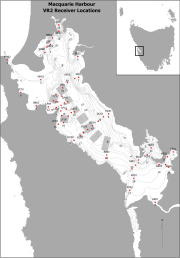ENVIRONMENTAL ASSESSMENTS
Type of resources
Topics
Keywords
Contact for the resource
Provided by
Years
-

This record provides an overview of the NESP Marine and Coastal Hub Research Plan 2023 project "Guiding research and best practice standards for the sustainable development of Offshore Renewables and other emerging marine industries in Australia". For specific data outputs from this project, please see child records associated with this metadata. -------------------- Australia is entering a phase of rapid development of offshore renewable energy (ORE) projects and there is an immediate need to ensure these developments occur in a socio-ecologically sustainable manner. This project will identify existing environmental and cultural data and best-practice monitoring standards to inform the sustainable development of ORE projects (primarily wind) in Australia and enabling regulatory decisions to be compliant with Environment Protection and Biodiversity Conservation (EPBC) Act and the Offshore Electricity Infrastructure (OEI) Act requirements. This project plans to run in conjunction with a second project that focusses on the immediate priorities of regulators, with a focus on the confirmed area of declaration for ORE off the east Gippsland coast, Victoria. Critical to informing the direction and focus of these projects is guidance from an ORE Program Steering Committee, that will comprise representatives from relevant sections within DCCEEW, NOPSEMA, and MaC Hub partners involved in this project. Outputs • Inventory of existing information and associated sources for the following thematic areas: seabed geomorphology and habitat, oceanography, species and habitats, affected indigenous communities, ongoing monitoring needs and associated best practices, potential impacts of installation and operation [data inventory] • Final project report [written]
-

This record provides an overview of the NESP Marine and Coastal Hub Research Plan 2023 project "Identifying priority datasets of relevance to the Gippsland declaration area and pathways for their use in guiding decision-making". For specific data outputs from this project, please see child records associated with this metadata. -------------------- Australia has entered a phase of rapid development of offshore renewable energy (ORE) with one declaration area and one notice of proposal to declare an area for ORE infrastructure announced in late 2022 and early 2023 respectively. There is an immediate need to ensure that assessment and regulatory processes can access relevant information on species protected under environmental legislation comprehensively and efficiently, to ensure that decisions are evidence based, gaps in understanding are identified and future research and monitoring is directed to fill those gaps. This project will undertake a rapid exploration of information on a priority subset of species identified by the Department of Climate Change, Energy, Environment and Water (DCCEEW) and the National Offshore Petroleum Safety and Environment Authority (NOPSEMA) identified as critically endangered or endangered under the Environment Protection and Biodiversity Conservation Act 1999 in relation to the Gippsland declaration area. The project aims to 1) identify datasets and information sources relevant to these priority species; 2) identify the level of accessibility of these datasets and information source;, 3) based on the outcomes of 2), evaluate the utility of information identified for assessments required to be undertaken by DCCEEW and NOPSEMA; and 4) identify what activities would need to be undertaken to improve the accessibility and utility of datasets and information sources not currently accessible in useable formats. This project does not intend to duplicate the efforts already being undertaken by NESP project 3.3 in identifying information on marine ecosystems nationally and producing an inventory of recognised best practices for monitoring, mitigation and management of interactions and impacts that can be applied from installation to decommissioning, to be delivered in March 2024, but will fast-track some of the information that can be incorporated into project 3.3. Outputs • Inventory of datasets relevant to the Gippsland OEI declaration area, particularly with respect to priority species identified by DCCEEW and NOPSEMA in association with the Gippsland declaration area [data inventory] • Final project report [written]
-

Fixed position oxygen and water temperature logger data from the Macquarie Harbour World Heritage Area (WHA). Two Hobo oxygen data loggers are positioned at approximately 15 m depth at different sites within the WHA, with the intent of monitoring representative mid-bottom water oxygen values in the WHA as these were identified in previous studies to be naturally low due to limited seawater exchange at the harbour entrance, and thus likely to be most susceptible to anthropogenic factors that may increase oxygen demand and alter WHA conservation values. These values include core habitat of the Maugean Skate, a listed threatened species. This work is funded by WHA advisory board via the Nature Conservation Branch of DPIPWE and is part of a larger study being conducted by IMAS undertaking a biological baseline study of the biodiversity of the Macquarie Harbour WHA. This data spans 08/11/14 to present (most recent update 02/02/17).
 IMAS Metadata Catalogue
IMAS Metadata Catalogue